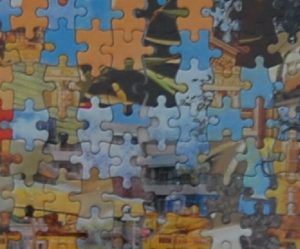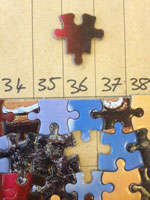Part of the reasoning for this piece is not only to replicate processes which generate glitch-alike or aesthetic-glitch images, but to put into place the conditions which could enable genuinely conceptual glitches to happen. As mentioned, a deliberate attempt to cause a glitch cannot be seen as a true conceptual glitch, so all possible attempts have been made to avoid any foreseeable problems or errors.
I have considered the possibility of being hit by a bus, thus causing the piece to permanently glitch, though of course as it is a simple system, it could be carried out by any person or machine (as long as they have the capacities to perform the task). In the event of my death, it will have to be decided whether the process can be run by a different piece of hardware who could continue the jigsaw generations, or whether the process has permanently glitched, leaving the remaining frames empty. Our first glitch is not quite as dramatic, but does have a visible effect on the generated image.
Firstly, a note about how jigsaws are made:
I have had these jigsaws specially cut to the same pattern by an obliging company called JHG Jigsaws (and a very patient lady called Julie), so that a piece can be taken from a particular grid position on one jigsaw and placed in the same position on another.
Even so, it is not possible to stop the boards from shifting slightly in their frames as they are being cut, meaning that whilst the inner shapes are regular, the edges of the jigsaws are of different lengths. When mixed up together, this leads to jagged edges:

In addition, virtually all jigsaws are made in two halves which are then attached down the middle (if you pull apart any standard jigsaw, you will notice a gap down the middle where the two halves connect). One side is the rotated copy of the other, so that the bottom left and the top right pieces are the same but 180 degrees rotated. As the middle is also two edges, they also obey the jagged edges rule, and as a result, do not fit together neatly as they would normally.

I do not consider this a conceptual glitch, as I had predicted it, and the pieces can still be placed together without much interference, though not as tidily.
However, in the creation of Circuit-bent jigsaw #2, it became apparent that there was an anomaly, namely B36 and the pieces either side of it. In short, it was too large to fit the space.

On investigation, I found that Jigsaws 2 and 6 share this anomaly, which is of course mirrored in the bottom left corner at X5 (where the piece was smaller, so could fit, though with some empty space).
This begs the question, how should the system react to such an anomaly? It seems there are 3 options:
1) Leave the piece out
2) Cut the piece/surrounding pieces to fit
3) Replace the piece with a smaller piece from that position from the next jigsaw along.
Option 2) seems like a very human solution to apply to an automated, pre-determined process so can be rejected.
Option 3) suggests an alteration in the programme to accommodate new information, i.e. the system is learning. There is no reason to think that the system has any such capability.
Therefore, Option 1) is the most realistic reaction. The unit contains no information and as such will be left blank, an absence, a dead pixel.
